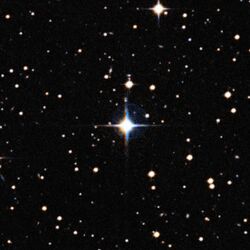Astronomy:HD 197027
| Observation data Epoch J2000.0 Equinox (celestial coordinates) | |
|---|---|
| Constellation | Capricornus |
| Right ascension | 20h 41m 54.6336s[1] |
| Declination | −27° 12′ 57.4154″[1] |
| Apparent magnitude (V) | 9.15±0.02[2] |
| Characteristics | |
| Spectral type | G3 V[3] |
| U−B color index | +0.30[4] |
| B−V color index | +0.65[2] |
| Astrometry | |
| Radial velocity (Rv) | −43.9±0.3[5] km/s |
| Proper motion (μ) | RA: +175.628[1] mas/yr Dec.: −15.593[1] mas/yr |
| Parallax (π) | 12.7715 ± 0.0164[1] mas |
| Distance | 255.4 ± 0.3 ly (78.3 ± 0.1 pc) |
| Absolute magnitude (MV) | 4.74[6] |
| Details | |
| Mass | 0.97[7] M☉ |
| Radius | 1.08+0.07−0.05[8] R☉ |
| Luminosity | 1.19[6] L☉ |
| Surface gravity (log g) | 4.40±0.02[9] cgs |
| Temperature | 5718±5[9] K |
| Metallicity [Fe/H] | −0.020±0.005[9] dex |
| Rotational velocity (v sin i) | 1.78±0.12[9] km/s |
| Age | 6.92±0.69[9] Gyr |
| Other designations | |
| Database references | |
| SIMBAD | data |
HD 197027 (HIP 102152) is a star in the constellation Capricornus. It has an apparent magnitude of 9.15,[2] making it readily visible through a telescope but not to the naked eye. The object is located at a distance of 255 light years but is approaching the Solar System with a heliocentric radial velocity of −44 km/s.[5]
HD 197027 has a stellar classification of G3 V, indicating that it is an ordinary G-type main-sequence star like the Sun. It has only 97% the mass of the Sun[7] but 108% of its radius.[8] It shines at 119% the luminosity of the Sun[6] from its photosphere at an effective temperature of 5,718 K,[9] similar to the Sun's 5,778 K. HD 197027's metallicity – elements heavier than helium – is similar to the Sun.[9] At an older age of 6.92 billion years, it spins with a projected rotational velocity of about 2 km/s.[9]
Since its measured properties of this star are very similar to those of the Sun, it has been considered a candidate older solar twin.[11] The abundances of 21 elements overall are more similar to the Sun than any other known solar twin. [citation needed] Its Iron Abundance is -0.03 with an error value of 0.02 Fe/H. (The value comes from the Hipparcos Extended Catalog.)[12]
Age

References
- ↑ 1.0 1.1 1.2 1.3 1.4 Brown, A. G. A. (2021). "Gaia Early Data Release 3: Summary of the contents and survey properties". Astronomy & Astrophysics 649: A1. doi:10.1051/0004-6361/202039657. Bibcode: 2021A&A...649A...1G. Gaia EDR3 record for this source at VizieR.
- ↑ 2.0 2.1 2.2 Høg, E.; Fabricius, C.; Makarov, V. V.; Urban, S.; Corbin, T.; Wycoff, G.; Bastian, U.; Schwekendiek, P. et al. (March 2000). "The Tycho-2 catalogue of the 2.5 million brightest stars". Astronomy and Astrophysics 355: L27–L30. ISSN 0004-6361. Bibcode: 2000A&A...355L..27H.
- ↑ Houk, N. (1982). Michigan Catalogue of Two-dimensional Spectral Types for the HD stars. Volume_3. Declinations -40_ƒ0 to -26_ƒ0.. Bibcode: 1982mcts.book.....H.
- ↑ Paunzen, E. (May 2022). "Catalogue of stars measured in the Geneva seven-colour photometric system". Astronomy & Astrophysics 661: A89. doi:10.1051/0004-6361/202142355. ISSN 0004-6361. Bibcode: 2022A&A...661A..89P.
- ↑ 5.0 5.1 Gontcharov, G. A. (November 2006). "Pulkovo Compilation of Radial Velocities for 35 495 Hipparcos stars in a common system". Astronomy Letters 32 (11): 759–771. doi:10.1134/S1063773706110065. ISSN 1063-7737. Bibcode: 2006AstL...32..759G.
- ↑ 6.0 6.1 6.2 Anderson, E.; Francis, Ch. (May 2012). "XHIP: An extended hipparcos compilation" (in en). Astronomy Letters 38 (5): 331–346. doi:10.1134/S1063773712050015. ISSN 1063-7737. Bibcode: 2012AstL...38..331A.
- ↑ 7.0 7.1 Talawanda R. Monroe (Aug 2013). "High Precision Abundances of the Old Solar Twin HIP 102152: Insights on Li Depletion from the Oldest Sun". Astrophysical Journal Letters 774 (2): L32. doi:10.1088/2041-8205/774/2/l32. Bibcode: 2013ApJ...774L..32M.
- ↑ 8.0 8.1 Stassun, Keivan G. et al. (9 September 2019). "The Revised TESS Input Catalog and Candidate Target List". The Astronomical Journal 158 (4): 138. doi:10.3847/1538-3881/ab3467. ISSN 0004-6256. Bibcode: 2019AJ....158..138S.
- ↑ 9.0 9.1 9.2 9.3 9.4 9.5 9.6 9.7 dos Santos, Leonardo A. et al. (August 2016), "The Solar Twin Planet Search. IV. The Sun as a typical rotator and evidence for a new rotational braking law for Sun-like stars", Astronomy & Astrophysics 592: 8, doi:10.1051/0004-6361/201628558, A156, Bibcode: 2016A&A...592A.156D.
- ↑ "HD 197027". SIMBAD. Centre de données astronomiques de Strasbourg. http://simbad.u-strasbg.fr/simbad/sim-basic?Ident=HD+197027.
- ↑ ESO, The life cycle of a Sun-like star (annotated), from European Southern Observatory, 28 August 2013
- ↑ "HD 197027 Star Distance, Age, Colour and other Facts - Universe Guide" (in en-us). 10 January 2024. https://www.universeguide.com/star/102152/hd197027.
External links
- Oldest Solar Twin Identified
- HIGH PRECISION ABUNDANCES OF THE OLD SOLAR TWIN HIP 102152: INSIGHTS ON LI DEPLETION FROM THE OLDEST SUN
- Oldest Solar Twin Identified
 |


